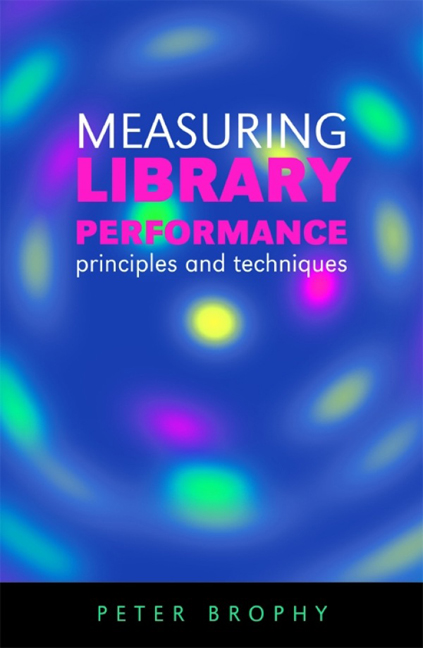Book contents
- Frontmatter
- Contents
- List of figures
- List of tables
- Preface
- Acronyms and abbreviations
- 1 Background
- 2 Theoretical considerations
- 3 User satisfaction
- 4 Impact on users
- 5 Social and economic impact
- 6 Inputs
- 7 Processes
- 8 Outputs
- 9 Staff
- 10 Infrastructure
- 11 Services for all
- 12 Benchmarking
- 13 The balanced scorecard
- 14 Standards
- Appendix 1 Data collection methods
- Appendix 2 The analysis of data
- Appendix 3 The presentation of results
- Index
- Frontmatter
- Contents
- List of figures
- List of tables
- Preface
- Acronyms and abbreviations
- 1 Background
- 2 Theoretical considerations
- 3 User satisfaction
- 4 Impact on users
- 5 Social and economic impact
- 6 Inputs
- 7 Processes
- 8 Outputs
- 9 Staff
- 10 Infrastructure
- 11 Services for all
- 12 Benchmarking
- 13 The balanced scorecard
- 14 Standards
- Appendix 1 Data collection methods
- Appendix 2 The analysis of data
- Appendix 3 The presentation of results
- Index
Summary
■ Introduction
In measuring the performance of a library or information service, it is easy to concentrate almost entirely on the broad picture and thus lose sight of the service being received by particular user groups. In this chapter we will be looking at ways in which success in meeting the needs of such groups can be assessed. A particular emphasis will be placed on users with disabilities (or, more properly, different abilities). However, all libraries should carefully consider how they are addressing the needs of all the subgroups in their populations, bearing in mind comments such as that in Chapter 5, ‘Social and economic impact’, that ‘the public library service has not yet managed to engage freely with ethnically diverse communities’ (and there is no evidence that other sectors are any better). By developing the library profile (see Chapter 6, ‘Inputs’) to include such groups, regular measurement of performance in meeting specific requirements can be encouraged. Williams (2004) suggests that libraries should be considering, and monitoring their performance in serving, people who are ‘different’ in all of the following ways:
• age
• ancestry
• cognitive style
• cultural background
• economic background
• ethnicity
• gender
• geographic background
• language(s) spoken
• marital/partnered status
• nationality
• disability (mental, learning and physical)
• physical appearance
• political affiliation
• race
• religious beliefs
• sexual orientation.
As a general principle, the more that services can be differentiated to meet the specific needs of individuals and groups, the greater satisfaction with those services is likely to be and the more probable it is that customers will return time and time again. For this reason, there has been considerable interest in the possibilities of personalization, and this is the topic we turn to first in this chapter.
■ Personalization
The idea behind personalization, in terms of electronic services in particular because it is there that the scope is greatest, is that each individual should be able to tailor the ‘look and feel’ of the information which is displayed on their workstation, so that it matches their personal requirements both in terms of content and presentation. An advantage of this approach is that it enables people to express their individuality and their personal needs for themselves.
- Type
- Chapter
- Information
- Measuring Library Performanceprinciples and techniques, pp. 138 - 146Publisher: FacetPrint publication year: 2006



